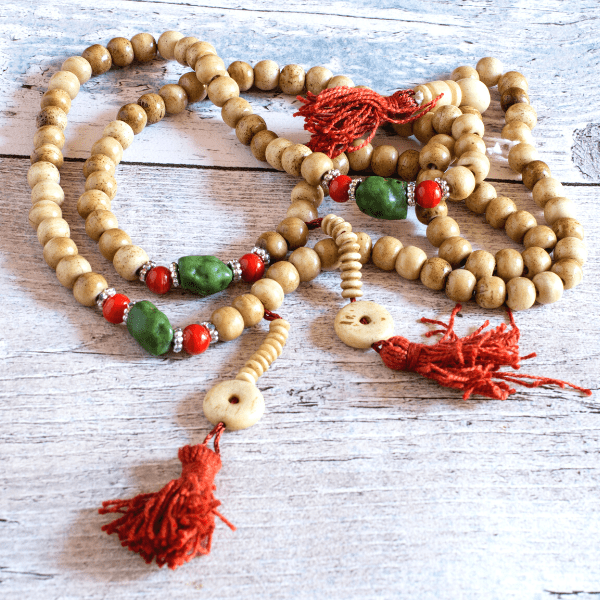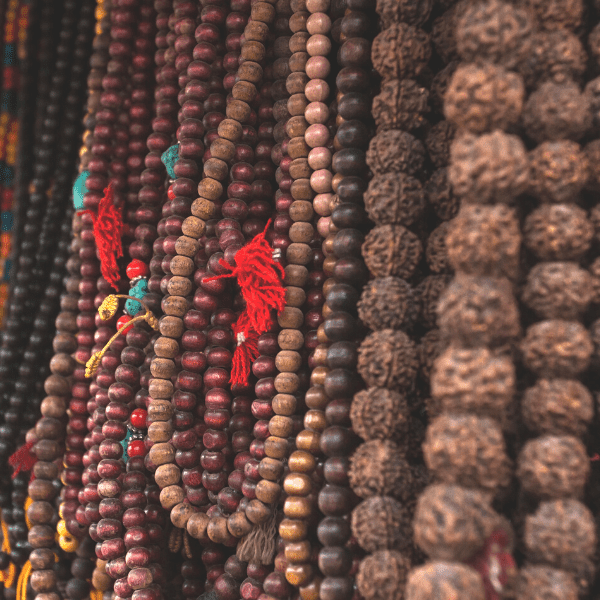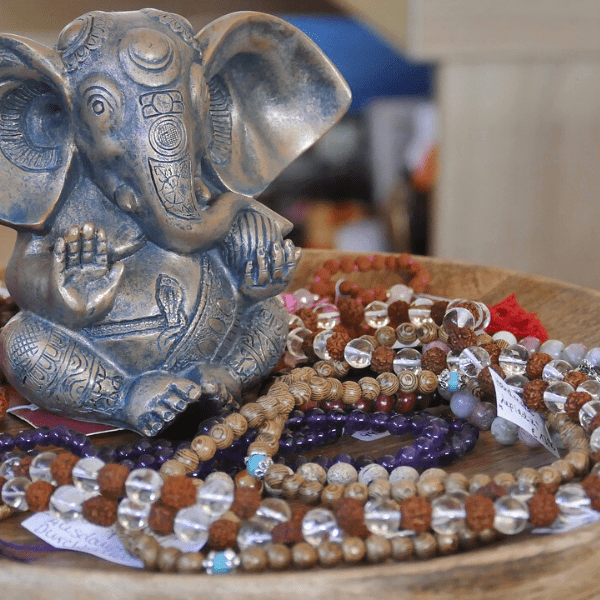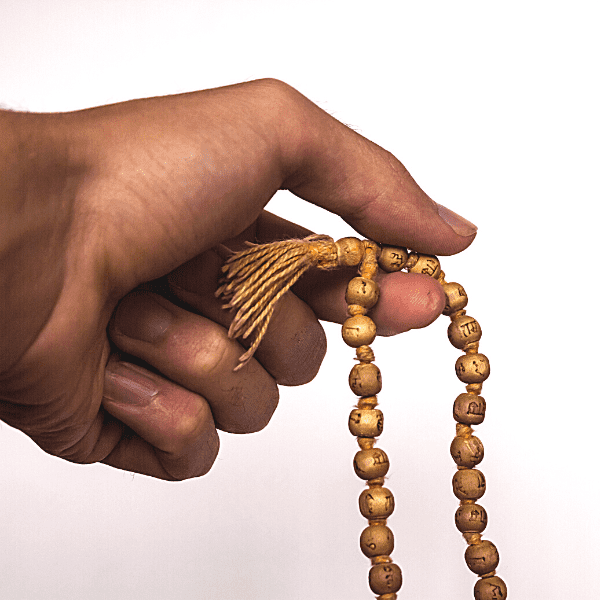Mālā Beads
What are they and how can we use them?
The Mālā
The Mālā (translated as garland) is a string of beads threaded and knotted to form either a neckace or a bracelet.
Mālā Beads come in many beautiful designs. They can be made from wood, bone, glass and semi-precious gem stones. And while each design may be unique, there is usually one common factor – the full Mālā all have 108 beads: 109 including the Guru Bead (or Sumera).
Why 108 Beads?
There are some variations to the 108 bead design, but this is generally the number of beads found commonly in Mālā necklaces. The number 108 has many numerological and spiritual significances. You can find a comprehensive list at Swami J, but here are a few of the main ones:-
• 108 energy lines converge into the Heart Chakra
• The Sanskrit Alphabet has 54 letters, and each has a masculine and feminine = 108
• 108 is a Harshad number: an integer divisible to the sum of it’s digits
• In Astrology, there are 12 Houses and 9 Planets = 108
• The shape of the digits has spiritual significance: 1 = God/Truth 0 = Emptiness/Void 8 = Infinity
• In India, there are 108 Sacred Sites, 108 Upanishads and 108 Marma (pressure points) in the body
• Planetary – the average distance of the Sun and the Moon to Earth is 108 times their diameter
• And so the Legend goes, if we can slow our breath down to 108 per day, enlightenment will come! (Any mathematicians out there? How many breaths per minute would that equate to? Leave your comments below!)
The Design of the Mālā
Each bead is separated from the ones either side of it by a knot, called the ‘brahma granti’, or the ‘Knot of Brahma’. This creates space between the beads and makes it easier to move each bead through the fingers.
Traditionally, Indian Mālās were made from several different types of wood, and according to Swami Nishchalananda, each wood brings a different quality to the Mala.
Red Sandalwood – Calms emotions
White Sandalwood – Induces peace and harmony
Tulsi – Awakens devotion
Rudraksha – Induces non-attachment, and is often used by renunciants and devotees of Shiva.
Crystals and Gem Stones – Each one will have a specific vibration and quality. Most common ones used are Rose Quartz – the stone of Universal Love, and Amethyst – the stone of balance and peace.
Mini Mālā
A smaller version of the Mālā, called the sumirani, containing 27 beads is often worn around the wrist. Sumirani means ‘that which reminds us’, and can be used throughout the day as a reminder to maintain our awareness.



What are Mālā Beads used for?
Mālā beads are used primarily for meditation and for mantra recitation. Developed in an age before we had timers and clocks, the beads were used to record how many repetitions of each mantra had been recited.
The action of counting and moving the beads methodically through the fingers also adds an element of attention and awareness – an additional layer to help to focus the mind.
How to use the Mālā
Traditionally, the Mālā is held in the right hand (due to cultural connotations with the left hand in India). The beads are held between the tip of the thumb and the ring finger.
To move through the Mālā, the middle finger guides each bead along. The index and little fingers are unused, and held away from the beads.
A more common, and easier hold is to drape the Mālā over your last three fingers, and to move each bead with your thumb.
To begin your practice, start at the Guru Bead, or sumera – this is the largest bead, or can be a tassel. Move each bead through your hand with each repetition of the mantra, until you reach the Guru Bead again. This signifies you have completed 108 repetitions.

If you are observing more than one round of the Mālā, count the rounds on the fingers of your left hand by moving your thumb along each joint of your index finger.
Some sources recommend using a different Mālā for each mantra that you chant. However, my own Guru confirms that it is fine to use the same Mālā for all your mantras. Each time you use it, the energy from the mantra will be infused into your Mālā, making it a very sacred tool for your yoga practice.
Sources
- ‘Mantra Yoga and Ashram Chants‘ by Swami Nishchalananda, Mandala Yoga Ashram
FREE Meditation Practice!
Would you like to try out a wonderful guided meditation for free and check out the content, style and quality of my teaching? The Heart Lotus Peace Meditation develops powerful feelings of loving peace in the heart space, using the imagery of a lotus. The peaceful energy cultivated in the heart is then radiated outwards to embrace every being on the planet. This is a truly powerful meditation experience.
SIGN UP to receive the Video Recording and PDF Notes.
– Transcript of the Video Recording
– Video : Full, guided 20 minute Meditation
– Introduction to the Meditation and preparatory practices
Would you like to learn more about Mantra or Meditation?
Check out this upcoming Training Course for a deep dive into Sanskrit, Meditation & Yogic Chanting. Learn to pronounce Sanskrit correctly. Develop a sequential meditation practice. Learn about the various deities and styles of Yogic Chanting.
The course will radically change your personal practice and completely elevate your Yoga Teaching.
Find out more below…
Breathe Smile Love
Privacy Policy | About | Home
© Divine Works 2018 | All Rights Reserved |
Designed by Julie Hemmings | Powered by Divi Theme & WordPress

